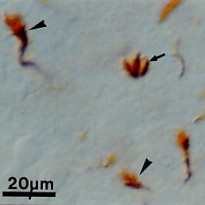ARG22517
anti-67 kDa Laminin Receptor antibody [2G13]
anti-67 kDa Laminin Receptor antibody [2G13] for IHC-Frozen sections,IHC-Formalin-fixed paraffin-embedded sections and Mouse,Rat,Chicken
Overview
| Product Description | Mouse Monoclonal antibody [2G13] recognizes 67 kDa Laminin Receptor This antibody recognizes a protein originally termed 2G13P which is localized to growth cones. Subsequent investigation has identified this protein to be 40S ribosomal protein SA, also known as 37 kDa laminin receptor precursor or Laminin receptor 1 (Baloui et al. 2004). 40S ribosomal protein SA is a 296 amino acid ~37kDa membrane, cytoplasmic and nuclear protein required for the assembly and/or stability of the 40S ribosomal subunit.. In vertebrate evolution the molecule has acquired a secondary function as a laminin receptor (UniProt: P50890). In growth cones expression is notable particularly in filopodia and lamellipodia in developing rat CNS and embryonic neurons in culture (Stettler et al. 1999).40S ribosomal protein SA interacts with the filamentous actin cytoskeleton and therefore may be involved in growth cone motility (Stettler et al. 1999). Mouse anti Growth Cone antibody, clone 2G13 has been used for the detection of growth cones by immunohistochemistry and identification of 40S ribosomal protein SA by western blotting in chicken and rat samples (Baloui et al. 2004). |
|---|---|
| Tested Reactivity | Ms, Rat, Chk |
| Tested Application | IHC-Fr, IHC-P |
| Host | Mouse |
| Clonality | Monoclonal |
| Clone | 2G13 |
| Isotype | IgM |
| Target Name | 67 kDa Laminin Receptor |
| Antigen Species | Chicken |
| Immunogen | Embryonic chick tectal membranes. |
| Conjugation | Un-conjugated |
| Alternate Names | Colon carcinoma laminin-binding protein; 67LR; lamR; 37LRP; 37/67 kDa laminin receptor; p40; LBP; LRP; Laminin-binding protein precursor p40; LamR; 40S ribosomal protein SA; Laminin receptor 1; LRP/LR; ICAS; LAMR1; LBP/p40; NEM/1CHD4; 37 kDa laminin receptor precursor; 67 kDa laminin receptor; Multidrug resistance-associated protein MGr1-Ag; SA; LAMBR |
Application Instructions
| Application Suggestion |
|
||||||
|---|---|---|---|---|---|---|---|
| Application Note | Immunohistology: This product does not require protein digestion pre-treatment of paraffin sections. This product does not require antigen retrieval using heat treatment prior to staining of paraffin sections. * The dilutions indicate recommended starting dilutions and the optimal dilutions or concentrations should be determined by the scientist. |
Properties
| Form | Liquid |
|---|---|
| Purification | Tissue Culture Supernatant |
| Buffer | 0.2M Tris/HCl (pH 7.4), 5-10% foetal calf serum and 0.09% Sodium azide. |
| Preservative | 0.09% Sodium azide |
| Storage Instruction | For continuous use, store undiluted antibody at 2-8°C for up to a week. For long-term storage, aliquot and store at -20°C or below. Storage in frost free freezers is not recommended. Avoid repeated freeze/thaw cycles. Suggest spin the vial prior to opening. The antibody solution should be gently mixed before use. |
| Note | For laboratory research only, not for drug, diagnostic or other use. |
Bioinformation
| Database Links | |
|---|---|
| Gene Symbol | RPSA |
| Gene Full Name | ribosomal protein SA |
| Background | Laminins, a family of extracellular matrix glycoproteins, are the major noncollagenous constituent of basement membranes. They have been implicated in a wide variety of biological processes including cell adhesion, differentiation, migration, signaling, neurite outgrowth and metastasis. Many of the effects of laminin are mediated through interactions with cell surface receptors. These receptors include members of the integrin family, as well as non-integrin laminin-binding proteins. This gene encodes a high-affinity, non-integrin family, laminin receptor 1. This receptor has been variously called 67 kD laminin receptor, 37 kD laminin receptor precursor (37LRP) and p40 ribosome-associated protein. The amino acid sequence of laminin receptor 1 is highly conserved through evolution, suggesting a key biological function. It has been observed that the level of the laminin receptor transcript is higher in colon carcinoma tissue and lung cancer cell line than their normal counterparts. Also, there is a correlation between the upregulation of this polypeptide in cancer cells and their invasive and metastatic phenotype. Multiple copies of this gene exist, however, most of them are pseudogenes thought to have arisen from retropositional events. Two alternatively spliced transcript variants encoding the same protein have been found for this gene. [provided by RefSeq, Jul 2008] |
| Function | Required for the assembly and/or stability of the 40S ribosomal subunit. Required for the processing of the 20S rRNA-precursor to mature 18S rRNA in a late step of the maturation of 40S ribosomal subunits. Also functions as a cell surface receptor for laminin. Plays a role in cell adhesion to the basement membrane and in the consequent activation of signaling transduction pathways. May play a role in cell fate determination and tissue morphogenesis. Acts as a PPP1R16B-dependent substrate of PPP1CA. Also acts as a receptor for several other ligands, including the pathogenic prion protein, viruses, and bacteria. [UniProt] |
| Calculated MW | 33 kDa |
| PTM | Acylated. Acylation may be a prerequisite for conversion of the monomeric 37 kDa laminin receptor precursor (37LRP) to the mature dimeric 67 kDa laminin receptor (67LR), and may provide a mechanism for membrane association (PubMed:9581863). Cleaved by stromelysin-3 (ST3) at the cell surface. Cleavage by stromelysin-3 may be a mechanism to alter cell-extracellular matrix interactions. |
Images (1) Click the Picture to Zoom In






